Astro 25: "Field Astronomy in the California Mountains - Limestone
Caverns and the Fall Milky Way in Sierra Gold Country"
Sept 19, Sept 27-29, 2024
Instructor's Post-Trip Photo Page for Fall 2024 (coming soon)
Kirk Bender's Post-Trip Photo page (soon)
Fall 2017's Caverns Post-Trip Photo Page
Summer 2022 A25 Caverns Post-Trip Photo Page from Kirk Bender
============================================================================================================================
Office Hours:
Monday 11:00am-12 noon
, 5:30-6pm
Mon, both in 706a
Tuesday 6:15-7:15pm at the Observatory (or 705 if cloudy)
Wednesday 11-12pm in 705
Wed 6:15-7:15pm in 705 and by appointment
This field class is returning to a favorite site of our - the Stanislaus River and its limestone caverns. I really enjoy fixing group meals that keep everyone together for educational and socializing purposes, however, you're free to opt for your own food and cooking. Let me know at our Pre-trip.
The campground we like (Wakalu Hep Yo) is now open, it is first come / first serve with no reservations, so we will be particularly keen on having any people who want to arrive early and grab ~3 campsites for us. We have volunteer Pascal who will be arriving early and securing (we hope!) the 3 sites below that we have used in the past.
We drive on Hwy 4 to Dorrington, and then follow the sign to "Boards Crossing", winding through the cabins of Dorington and down to the river. Just before crossing the river, is Wakalu Hep Yo campground on the left. Just drive straight up through the lower campsites up to the where the road tops out, and see the bathroom on the right. Park and see if you can claim or occupy the 3 campsites showh below.
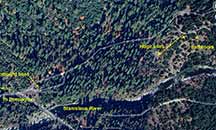
We want to grab the 3 ridge campsites marked with the yellow 'x', and not the small site under the trees next to it. |
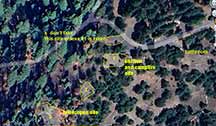
The ideal plan is to have the kitchen tables and cooking gear at the "site #1", and I'll pitch tent nearby. Site #2 is for students to spread around, and also on the edges of site #3. Site #3 is also for the telescopes as it has the best view of the sky and away from other campers. |
|
|
|
You'd find your way to our proposed campground used on the prior 2017 Fall Astro 25 trip. You'd be camping in your own tents, For our Saturday explorations, we'll explore Coyote Creek, where there's a creek which tunnels through limestone ridges in two places. (Natural Bridge natural area) which is very interesting and has many of the formations seen in California Caverns, and a great place to enjoy cool water on a hot summer day. I'd have my usual micro-lectures on the trails as we hike to this spot (just a 2-3 mile hike round trip), and there's the Stanislaus River itself we can enjoy right at camp. We'll have volunteer telescope operators as in the past. For sure you'd have yours truely with Cabrillo Observatory equipment!
I will continue to update this page. Check back regularly. It's still possible we may find an alternate site, although the WakaLu HepYo (means "Wild River" in Native language) campground has become our most popular destination considering travel time, dark skies.
Sept 19, 2024 Thursday evening 6-9pm
This meeting is on campus, in room 705, next to my office (my office is 706a and labelled "planetarium"). This room is the Geology/ES/Oceanography lab room and nice for groups of 20 or fewer, and convenient if I have to grab something from my office. We will not need the full 3 hours on the Schedule. We'll try to wrap early. We can't have a planetarium session because our planetarium is currently in repairs. I can show slides of our first lecture on stars/planet formation in our lecture room however. The most important logistics will be done for this pre-trip meeting first. That includes...
Liability Waivers
All students attending the camping trip must sign and return the liability waiver, linked here, and in our Canvas page under 'files' as well.
Sept 27-29, 2024
Below is our plan for the In-the-Field class. Your grade will depend largely on your scores on the exams, and participation effort. The exam(s) will be offered on Canvas and you'll do these after returning from our field trip. So, do pay attention to the Canvas pages for this course! But more detailed information and images are to be found here, on our website for the course.
Post-trip Schedule of Classes meeting - is just a placeholder! We don't actually meet. It's a date needed to insure that the grade people give us time to complete work. Nominally, an instructor is supposed to turn in grades 48hrs after the completion of the class. That's not practical for a field class. So... I put in another date and some hours, but they're just for a placeholder to insure the end of the class is later than the end of the field trip.
Here is a published table of the PDF's of the lectures for this class, for your use when you start on the quizzes published in Canvas and which will largely determine your grade. Note there are also some YouTube versions of these, me lecturing!
Supplementary Table of my Presentations and YouTube lectures
===========================================================================================================================
This field astronomy course will
keep us busy both staring upward at the universe, and staring deep underground
at the amazing geologic processes happening in limestone caverns. With the recent
discovery of possible running water and also limestone formations on Mars, the
processes we'll study here may happen more widely on other planets.
Here's a link to the
formation of Caverns. and some recent work using them for studying paleo climate change. We camped near here and explored the caverns as part of Astro 28X back in Spring '08. Check out the photos from that adventure. Farther up Hwy 4 back in '01 for Astro
28E; before I was so meticulous about digital photo-recording everything.
However, check out the pix I did get at the link. We also went here just last year, in 2017, and had a great adventure. See the pictures here.
Pre-Trip Meeting. Sept 19 6-9pm (here's a Zoom recording of a prior version of this course, for reference)
This is our pre-trip meeting. This is the official beginning of the class, so any adds must be done before or during this class. We'll discuss the campground, rules for avoiding CoVid, directions to our campsite and other particulars. And then a lecture on planetary formation in stellar clusters and nebulae. I will need to distribute liability waiver forms. Students attending the camping trip need to sign a liability waiver and return it before the trip, ideally before going home after the pre-trip meeting.. Here is the PDF of a similar PowerPoint I presented. We also had our first lecture on astronomy. It was on the formation of stars and planets, linked here.
Friday 9/27 at the Campsite
Our campground is at Wakalu Hep Yo Campground, entrance just a few yards before the Sourgrass Crossing over the Stanislaus River - We've enjoyed this site on several Astro 25's in the past. It is first come / first served at this time and the campsites best for astronomy were unoccupied (which is typical - most campers like to be under lots of trees). Still, I will want to get up there ASAP on Friday to grab spots. We have JP and our van driver Kenny, and Kirk and I trying to get their early and secure our preferred campsites along the little ridge above the campground road on the right side as you drive in. You'll drive in and up the road until it tops out, and that's where to look for us.

My Astro 28X class at California Cavern, Spring '08.
|
|
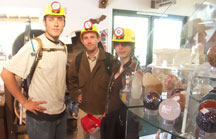
In the Rock Shop, ready for the descent |
Directions to get to our campground.
Get onto Hwy 4 going into the Sierra and pass through Arnold up to Dorrington. At Dorrington, look for Boards Crossing Rd. The Google Earth 'streetview' image of the intersection is below. Turn right onto Boards Crossing Rd, which winds through residential forested area and then splits into Forest Rte 5N02 and Boards Crossing. You want to take the left branch = Forest Rt 5N02, which leads to the campgrounds on the river after another ~2 miles. However, note that it's possible at thie no-reservations campground that is may be full before we get there, in which case our second choice is the Boards Crossing campground a couple miles back up and then down the road you came in on, down to "Boards Crossing" primitive campground. It would be a good idea to bring enough water for your personal needs in case we end up there. Here's the map
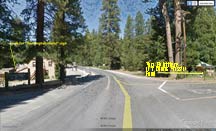
Here's the turnoff as you come up Hwy 4 at Dorrington, to turn right and head down to our campground possibilities
|

The map to our campground possibilities. #1 is the upper area, with the Wakaluu Hep Yoo campground and SourGrass Campground. If those are full and you don't find me, I will try to post a note on the message board and tell you to go back down to the river, cross the river and we'll make the day-use area our focus, camping in the dispersed camping area behind the day use and along the trail above the river.
|
|
|
|
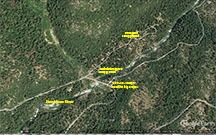
Google Earth view of our Wakaluu Hep-Yo campground. The turnoff into the campground is just before you cross the river, on your left. If you cross the river you've gone too far. Drive up along the campground road and look for a white Cabrillo College van, or Pascal's white pick up truck, or telescopes!
|
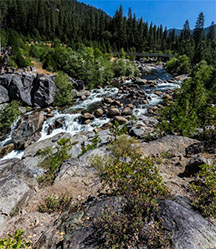
The Stanislaus River near the bridge |
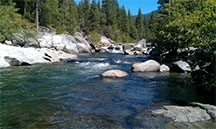
Another shot near our campsite
|

If somehow (very unlikely) Wakaluu Hep-Yo campground is full, our secondary choice camp area is at the bottom of this image at the Sourgrass day-use area. It's dispersed camping, which means we just occupy what we want. There may be other campers here as well.
|
|
Arrive at our campsite by around
6pm, if you're late, no worries. I can't fix you dinner so that aspect is moot! After you enjoy what dinner you brought, we'll take out the scopes and enjoy the beauties of the summer night sky. We'll study the galaxies and star formation regions and Milky Way that grace the Summer '22 evening sky.
Alas, all the planets now are in the morning sky. Get up early if you want to see them! However, Saturn should rise early enough to take a peak at. The great Andromdea Galaxyis high. in the east. Our little "Local
Group" - consisting of the Milky Way, Andromeda, and a posse of little
groupie dwarf galaxies, are on the outskirts of the Virgo Supercluster (cluster
of clusters!) of galaxies. Bring
your chocolate chip cookies to enjoy around the scopes! Our astronomy club members Kirk B and JP Lane are planning on joining us with their monster 12" and 17" Dobsonian telescopes, and probe for distant quasars and some of the farthest objects possible for any amateur astronomer to ever see, not must millions, but BILLIONS of light years away!
Bring warm clothes as we'll be above 4,000 ft elevation and it can get cool at night, even in late July.
Saturday Plan
7:30am Breakfast: My famous French Crepes breakfast! I will bring all the cooking gear and tables for prep and cleanup, and the silverware and plates.
Option: 10:30am After we clean up Breakfast, we'll carpool / drive the 45 minutes or so along the picturesque winding roads a few miles northwest of Arnold
for a guided tour of California
Cavern labelled "Cave City on your map. Students are responsible to pay the $20.00 fee - ( Group discounts are available and I will check on how we arrange that. Likely then $14/person). That's paid individually at the Cavern. Pleae bring cash to pay either me for the group discount, or the Park the larger amount of $19 for individuals. Then on to Natural Bridges on Coyote Creek. If we finish breakfast too late and/or students decide, we might just go to Natural Bridges. However, California Caverns are worth seeing.
10:30am after we clean up breakfast we pile into the vans and drive straight to Natural Bridges on Coyote Creek and study similar formations in an underground stream environment, with swimming underground! It's a beautiful spot, and cool too. And, it's free. The main cave is usually busy with locals and families. But we'd creek walk down a further 1/4 mile through the trees and arrive at a second cave, also with pools for cooling off, and last time we were there is was quiet and we had the place to ourselves. It's a great spot to relax and talk astronomy, cosmology, ET aliens, planets and more. I'll take a poll to see what you'd prefer. California Cavern is interesting, but it makes for a long day.
Directions to California Cavern if we choose this option.
Follow me in the Cabrillo College Van and / or use the maps here, which I'll staple together as part of our "map package" when I see you on-campus Oct 6. Coming up from the campground and onto Hwy 4, we drive down the mountain, looking for Avery-Sheep Ranch Rd, onto which we turn right....
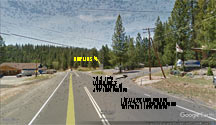
Here is where we turn right, onto Avery-Sheep Ranch Rd. From here, it's 17 miles and 40 minutes to the Californina Cavern
|

Stay on Sheep Ranch Rd as it winds through the hills and "T" ends at Sheep Ranch Rd. Turn right onto Sheep Ranch Rd
|
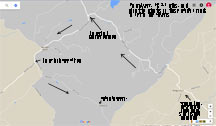
Stay on Sheep Ranch to Mtn Ranch, and turn left, and left again on Cave City Rd to California Cavern State Historical Monument at "Cave City".
|
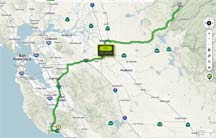
Mapquest Route. Might be a little slower on a Friday afternoon, though.
|
If/After the caverns, we'll visit and explore a really interesting pair of places, where a creek has dissolved its way right through two ridges, coming out the other side. It's called "Natural Bridge" and is at the bottom of a 1 mile hike down to this fascinating place. Here, Coyote Creek disappears into a giant limestone hole in the canyon. It's a great place to relax in the water, swim, and cool off while listening to some of my 'micro-lectures'. Myself; I plan to swim from one side to the other and back! There's supposedly an even better example another thousand yards downstream, which has a trail to it and we can explore that as well.
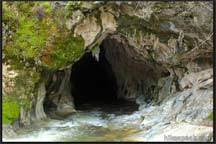
Natural Bridge Creek, disappears into a hole, but you can swim to the other side, 80 yards away
|

Map to Natural Bridge hiking trail. It's also the way towards Moaning Cavern, which we visited back in '08 but is only a vertical hole and not nearly as interesting as California Cavern.
|
|
|
|
Our goals: Study the process of precipitation and calcium carbonate
formation. I'll connect this to how we can determine the tipping point for the melting of the Siberian Permafrost in paleo climate. Very clever, ingenious idea worked out and successfully carried out by by Dr. Anton Vaks and his team 4 years ago. This is a key piece of science showing how serious our current climate change future will be.
After returning to camp, we'll explore
the Stanislaus River canyon right below our campsites. We'll study glacier and water carved granite formations
and lecture on the processes that shape canyons on Mars, the Moon, Mercury, Titan, and Earth. I'll also lecture on the Milakovitch cycles
and their grounding in the semi-chaotic nature of gravity in the solar system,
the last great Ice Age, and we'll have some relaxation time swimming in the
river.
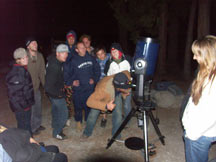
At the telescope; we'll use our computer-controlled 8" scope to direct us across the heavens' best study objects |
Saturday evening
-Dinner.
Follow up with more telescopic explorations of the evening sky. Contrasting
galaxy types, nearby star clusters and the structure of the Milky Way disk that
we live in. Late in the evening, the incredible objects of the Fall Milky
Way and the Sagittarius Spiral Arm will be in the West, and the supernovae remnant Veil Nebula high overhead. We'll study the birth
(in luminous emission nebulae) and death (in a final exhalation of their last
breath) of stars, with the Ring, Owl, and Dumbell nebulae. My lectures will focus on the discovery that we live in a Galaxy, Cepheids as cosmological distance indicators, the discovery of other galaxies, and that they are moving away from our own with a speed proportional to their distance (the Hubble Law) and implications for the origin of our Universe, and then to the quantum early universe and the new paradigm of the Multi-verse, and how it explains why life in our universe is natural and to be expected.
Sunday Plan
Breakfast. Scrambled eggs and chiles, veges, with Cowboy toast and fried veges. Then, we'll aim the
scope(s) w/ filter at the sun and I'll lecture on the solar cycles, their relation
to sunspots, and to Earth climate. We will do one more hike, down to the river right below us.
It would be short.
We should be done before noon. On the way back down, consider stopping at Calaveras Big Trees if you have never seen a Giant Sequoia - largest organisms
on Earth (I'm not going to count the creosote desert bushes or tangled underground fungus!). We might want an official stop on the way back, but I'd have to find something worthy of our attentions. Either way, we should be back in Santa Cruz by late afternoon if
you have studying to do, so no worries.
Provisions
* Meals : you can either take the meal option- bring $15 cash with you at the Pre-Trip meeting, or you can opt to bring your own food. Let me know BEFORE the trip because I have to buy our provisions and I hate wasting food.
*
Kenny Murray in the CEM Dept has joined the team again, joining us and driving a van primarily for transporting up to 8 students. The van can hold up to 7 or 8 students which may be enough for at least most of us. The other van - which I drive - will be packed with telescopes and gear and not available for students, alas. However, on our day tripping to the caverns I will be able to take students in my van as well.
After The Weekend - Grading and Exams
Our exams are on Canvas. Please go there and see and take the 3 exams (all multiple choice) I have created for you. Your scoring on these exams will weight heavily for your grade. You all showed great participation if you came on our weekend trip. Most of your grade, however, is from the exams. So, take any wisdom you can find from my PowerPoints linked and from the web if you feel so inclined, but know that I've already digested what the weight of evidence says, and so your answers should not conflict with my PowerPoints unless you can make a good argument that I'm incorrect!
As I write this, no one in the admin has bugged me about getting grades recorded and so I will leave these exams open as long as I can, within reason (like, end of October, I hope?)
Camper's Checklist

















